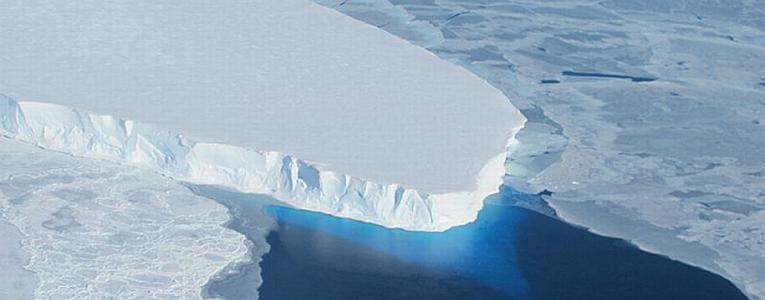 At a meeting of the American Geophysical Union yesterday, scientists from The International Thwaites Glacier Collaboration (ITGC) discussed the rapid retreat of Thwaites glacier and the implications that will have on our planet in the coming years. Thwaites, often referred to as the Doomsday Glacier, is massive, the size of Florida or Britain, and currently contributes four percent of annual global sea-level rise.
At a meeting of the American Geophysical Union yesterday, scientists from The International Thwaites Glacier Collaboration (ITGC) discussed the rapid retreat of Thwaites glacier and the implications that will have on our planet in the coming years. Thwaites, often referred to as the Doomsday Glacier, is massive, the size of Florida or Britain, and currently contributes four percent of annual global sea-level rise.
Thwaites glacier is retreating rapidly as a warming ocean slowly erases its ice from below, leading to faster flow, more fracturing, and a threat of collapse, according to an international team of scientists. If it does collapse, global sea levels could rise by several feet—putting millions of people living in coastal cities in danger zones for extreme flooding. The ice shelf, currently helping to restrain the glacier, could collapse within the next five to 10 years.
From a statement following the press conference:
“Thwaites is the widest glacier in the world,” said Ted Scambos, a senior research scientist at the Cooperative Institute for Research in Environmental Sciences (CIRES). “It’s doubled its outflow speed within the last 30 years, and the glacier in its entirety holds enough water to raise sea level by over two feet. And it could lead to even more sea-level rise, up to 10 feet, if it draws the surrounding glaciers with it.”
Scambos is the U.S. lead coordinator for the ITGC: a team of nearly 100 scientists funded by the U.S. National Science Foundation and U.K. Natural Environment Research Council dedicated to studying the vulnerable glacier. The five-year collaboration is aimed at collecting instrument data throughout the glacier and the adjacent ocean and modeling ice flow and the future of the ice sheet. Their work has revealed major changes in the ice, the surrounding water, and the area where it floats off the bedrock below.
Thwaites sits in West Antarctica, flowing across a 120km stretch of frozen coastline. A third of the glacier, along its eastern side, flows more slowly than the rest—it’s braced by a floating ice shelf, a floating extension of the glacier that is held in place by an underwater mountain. The ice shelf acts like a brace that prevents faster flow of the upstream ice. But the brace of ice slowing Thwaites won’t last for long, said Erin Petitt, an associate professor at Oregon State University.
Beneath the surface, warmer ocean water circulating beneath the floating eastern side is attacking this glacier from all angles, her team has found. This water is melting the ice directly from beneath, and as it does so, the glacier loses its grip on the underwater mountain. Massive fractures have formed and are growing as well, accelerating its demise, said Pettit. This floating extension of the Thwaites Glacier will likely survive only a few more years.
Warm water is also a threat for the so-called “grounding zone,” the area where the glacier lifts off the seabed, said Peter Davis, a physical oceanographer at the British Antarctic Survey. Davis and his team use hot water to drill access holes from the ice shelf surface to the ocean cavity hundreds of meters below. They have found that the ocean waters in the grounding zone are warm, by polar standards, and salty, and generate prime conditions for melting the ice shelf from beneath.
ITGC scientists warn that the demise of the ice shelf poses the biggest threat for sea-level rise this century.
Thanks to David Rye for contributing to this post.
